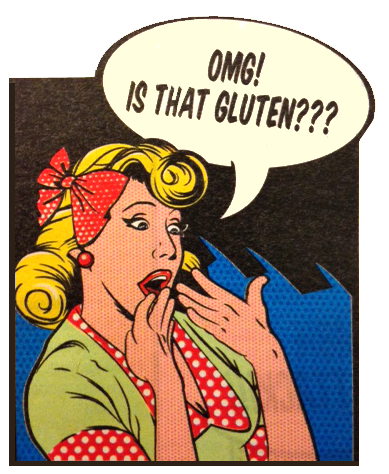Share This
Gluten is a mix of two proteins found in barley, rye, wheat and triticale (a wheat-rye hybrid). Wonderfully elastic, gluten makes it possible for dough to stretch and rise in the oven, creating crusty, delicious loaves of bread.
For thousands of years, bread has been considered the staff of life – until now, when misunderstandings about gluten have caused many people to mistrust even the heartiest loaf of artisan bread, as this illustration from Parade Magazine shows. (In the article, which was about “moral panics,” Parade suggested people should be afraid of not getting enough fiber if they skip whole grains, rather than fearing gluten.)
Other pushback came this week from NPR’s show On the Media, which examined diet fads, with gluten as the prime example. One of their conclusions: “Going gluten-free is celebrity-induced folly. Unless, of course, you have actually been diagnosed with celiac disease.”
How rampant is misinformation about gluten? An NSF International phone survey of 1,012 adults in May 2015 found the following:
47% think rice contains gluten
Wrong. Most grains are gluten free, including rice, corn, quinoa, amaranth, millet, teff, sorghum, wild rice, buckwheat and oats.
34% think potatoes contain gluten
Nope. Potatoes aren’t even a grain! Gluten is found only in wheat, barley, rye and a wheat-rye hybrid called triticale.
5% think gluten is found in all carbohydrates
These folks are probably unaware that fruits and vegetables are also carbohydrates. Folks with celiac disease would starve if all carbs were off-limits in a gluten-free diet!
26% think gluten is only found in wheat
While those answering the question above overestimated the presence of gluten, about a quarter of respondents underestimated its presence, saying that anything wheat-free would definitely be gluten-free.
11% of young adults think gluten-free diets help you lose weight
Gluten free diets only help you lose weight if you stop eating some of your favorite grain-based foods and don’t replace them with anything else.
Only 35% know what gluten is – but 48-62% say they know
Just about a third of those surveyed were able to accurately identify gluten as a protein found in wheat and related grains. Yet 62% of 18-34 year olds say they know what gluten is, and 48% of those over 65 say they’ve got it nailed.
Comedian Jimmy Kimmel explored this same topic – misunderstanding of gluten – last year, when he did on-the-street interviews asking folks following a gluten-free diet “What is Gluten?” As you can see on YouTube, no one really understood.
Consumer Reports tried its own survey, which it published in January 2015 in an article called “6 Truths about a Gluten Free Diet.” Among CR’s findings:
63% think that a gluten free diet would improve health
Supposed benefits (according to those questioned) included digestion, gastrointestinal function, weight loss, increased energy, lower cholesterol, and a stronger immune system – all unfounded for the general public, according to Dr. Alessio Fasano, interviewed in the article (and a speaker at our recent conference).
One quarter think gluten-free foods have more vitamins and minerals
Not true. In fact, Consumer Reports compared 81 gluten-free products across 12 categories with similar non-gluten-free products, and found that gluten-free products generally cost more, contained more sodium and sugar, and generally had more calories – while not offering more vitamins and minerals.
A report from Ardent Mills, titled “The Truth about Gluten Free” found that people talk about avoiding gluten, but perhaps because of their widespread lack of understanding of the terms gluten and gluten-free, “something unexpected was uncovered: … avoiding gluten does not mean buying gluten-free products.” By studying sales data, Ardent found that:
2.5% of U.S. households purchase 68% of all gluten-free products
While we hear daily about how the gluten-free market is growing rapidly – and it is – it’s important to remember that it’s still a tiny fraction of grain products. These core “heavy buyers” of gluten-free products spent only $185 annually per household, buying just 48 gluten-free products per year. The remainder of the market was made up of “medium” buyers (18% of sales), spending $24 per year, and “light” buyers (14% of sales), spending just $6 per year.
But those households don’t cut back on regular grain products
Ardent’s report found that those “heavy buyer” households may have added gluten-free products to their shopping carts, but they still bought the same amount of regular pasta, bread, crackers, etc. as households that don’t buy gluten-free products.
And gluten-free products are a fraction of total sales
As of 2012, gluten-free cookies and crackers were just 1.3% of total cookie and cracker sales, with gluten-free pasta (2.7% of total pasta) and gluten-free flour (2.6% of total flour) claiming the largest percentage of their respective categories. Overall, gluten-free specialty products averaged just 1% of total sales of similar products across categories.
Want to see how your understanding of gluten stacks up? Take this quiz on the WebMD site. (Cynthia)


Comments
Add a Comment